Investigating Impacts of Alternative Crop Market Scenarios on Land Use Change with an Agent-Based Model
Abstract
:1. Introduction
2. ABM of Agricultural Land Use
2.1. Mathematical Programming for Modeling Decision Making in ABM
2.2. Empirical Information for ABM
3. Study Area

4. Model Description
4.1. Overview
4.1.1. Purpose
4.1.2. Entities, State Variables, and Scales
| Parameter | Value | Agent Characteristics |
|---|---|---|
| Type | 0 | Not interested in either marketing corn stover or planting switchgrass |
| 1 | Only interested in marketing corn stover | |
| 2 | Only interested in planting switchgrass | |
| 3 | Interested in both | |
| Profit SWG | Numeric | Profit rate ($/ha) required by the farmer to plant, harvest and market switchgrass * |
| Percent1 SWG | Numeric | Percent of farm acreage on which the farmer would plant switchgrass if the Profit SWG can be achieved |
| Percent2 SWG | Numeric | Percent of farm acreage on which the farmer would plant switchgrass if 1.5 times the Profit SWG can be achieved |
| Profit Stvr | Numeric | Profit rate ($/ha) required by the farmer to harvest and market corn stover * |
| Percent1 Stvr | Numeric | Percent of farm acreage on which the farmer would consider harvesting and marketing corn stover if the Profit Stvr can be achieved |
| Percent2 Stvr | Numeric | Percent of farm acreage on which the farmer would harvest, and market corn stover if 1.5 times the Profit Stvr can be achieved |
| Portion Stvr | Numeric | Portion of corn stover that the farmer would harvest |
4.1.3. Process Overview and Scheduling
4.2. Design Concepts
4.2.1. Principles
4.2.2. Emergence
4.3. Details
4.3.1. Initialization
4.3.2. Input Data
4.3.3. Submodels
5. Data and Simulation Settings
5.1. Agricultural Landowners and Operators Survey
5.2. Price Scenarios and Simulation Settings
5.2.1. Historical Market Prices
5.2.2. Price Scenarios for Corn and Soybean
| Year | Corn | Soybean | Switch Grass | Corn Stover | N | P | K | Diesel | LPG | Soybean to Corn Ratio |
|---|---|---|---|---|---|---|---|---|---|---|
| 2003 | 102.36 * | 223.38 | 0 | 0 | 0.41 | 0.27 | 0.18 | 0.38 | 0.29 | 2.18 |
| 2004 | 103.54 * | 281.06 | 0 | 0 | 0.42 | 0.29 | 0.20 | 0.44 | 0.28 | 2.71 |
| 2005 | 103.54 * | 216.03 | 0 | 0 | 0.46 | 0.33 | 0.27 | 0.56 | 0.33 | 2.09 |
| 2006 | 103.54 * | 203.91 | 0 | 0 | 0.57 | 0.36 | 0.30 | 0.75 | 0.39 | 1.97 |
| 2007 | 132.68 | 285.84 | 0 | 0 | 0.58 | 0.46 | 0.31 | 0.73 | 0.40 | 2.15 |
| 2008 | 188.19 | 417.00 | 0 | 0 | 0.83 | 0.88 | 0.62 | 1.16 | 0.56 | 2.22 |
| 2009 | 150.00 | 369.60 | 0 | 0 | 0.75 | 0.70 | 0.94 | 0.57 | 0.43 | 2.46 |
| 2010 | 151.97 | 362.26 | 0 | 0 | 0.55 | 0.56 | 0.56 | 0.80 | 0.46 | 2.38 |
| 2011 | 234.65 | 458.88 | 0 | 0 | 0.83 | 0.70 | 0.66 | 1.06 | 0.49 | 1.96 |
| Simulation Set | Number of Combinations | Corn | Soybean | Soybean: Corn Price Ratio | Switchgrass | Corn Stover | SWG: Stvr Price Ratio | N | P | K | Diesel | LPG |
|---|---|---|---|---|---|---|---|---|---|---|---|---|
| II | 360 | Start = 102.36 To = 283.46 Step = 7.9 (24 levels) | Corn price SC price ratio (15 levels) | Start = 1.8 To = 3.2 Step = 0.1 (15 levels) | 0 | 0 | 0.89 | 0.80 | 0.76 | 1.03 | 0.48 | |
| III | 16 | 186.6 | 419.94 | 2.25 | Start = 58.41, To = 223.71, Step = 11 (16 levels) | SWG price/SS price ratio (16 levels) | 1.31 | 0.89 | 0.80 | 0.76 | 1.03 | 0.48 |
| IV | 96 | 186.6 | 419.94 | 2.25 | Start = 58.41, To = 223.71, Step = 11 (16 levels) | SWG price/SS price ratio (6 levels) | Start = 1.1, To = 2.1, Step = 0.2 (6 levels) | 0.89 | 0.80 | 0.76 | 1.03 | 0.48 |
5.2.3. Price Scenarios for Switchgrass and Corn Stover
6. Results and Discussions
6.1. Model Verification
6.1.1. Crop Rotation Pattern
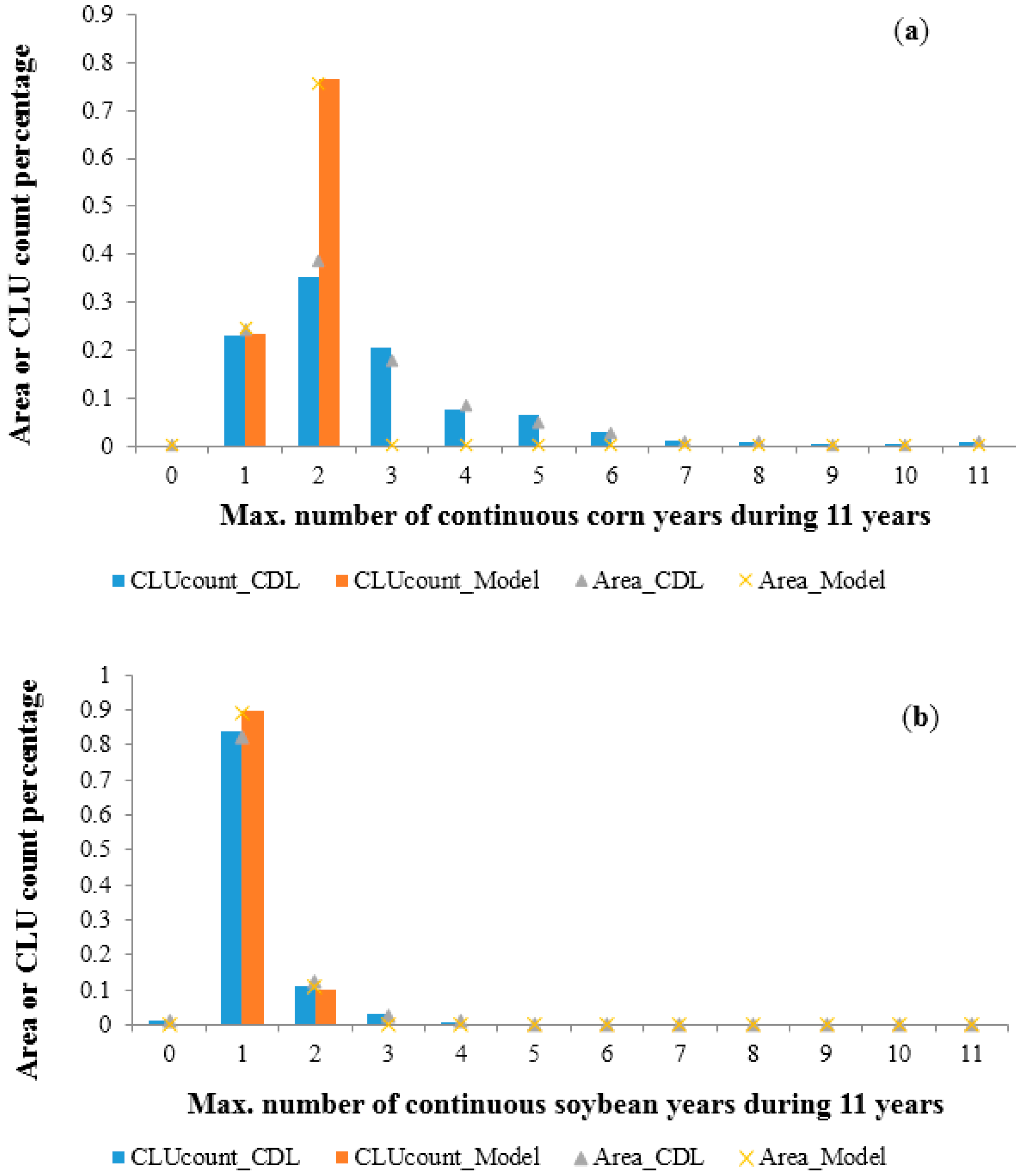
6.1.2. Field and Farm Scale Statistics
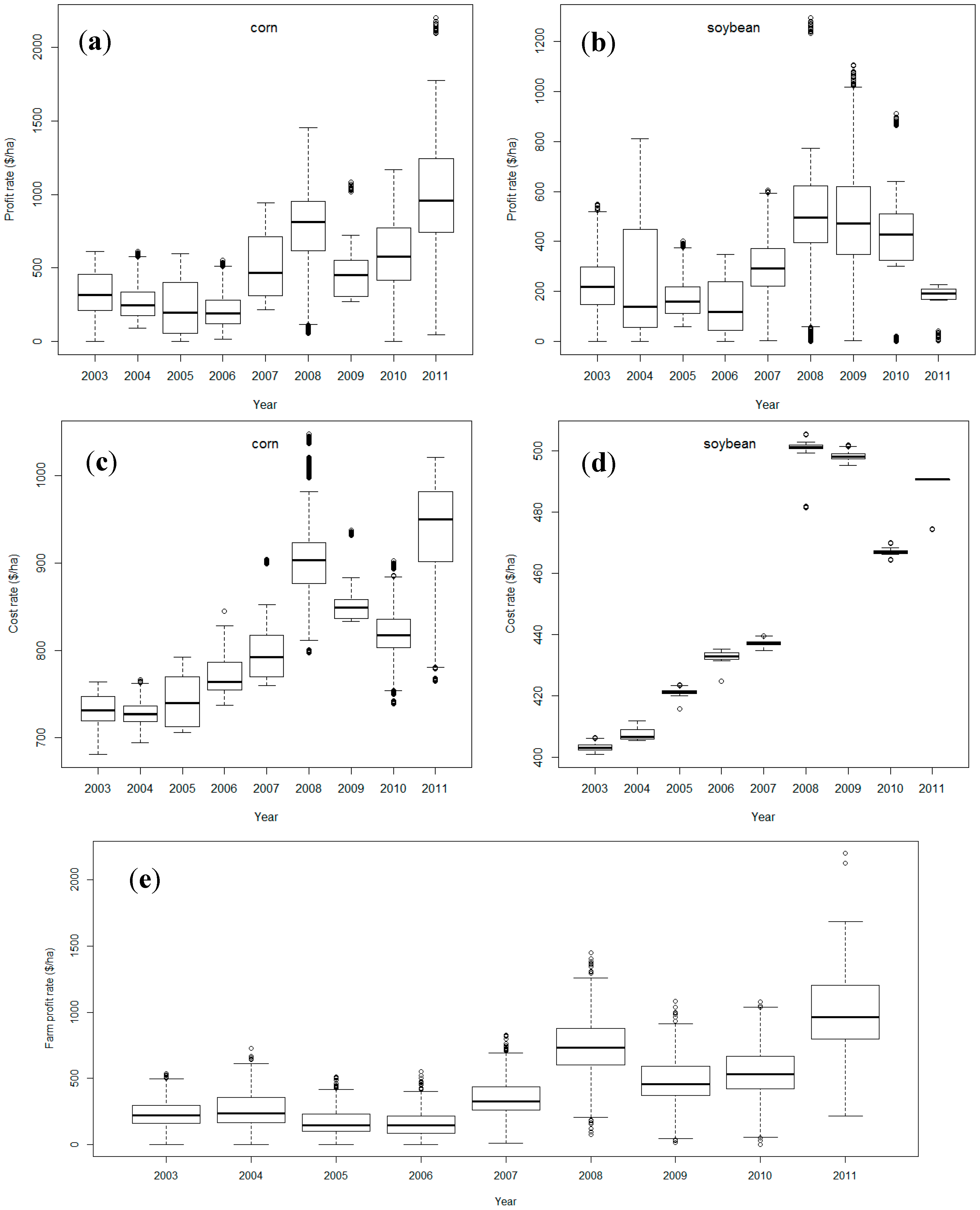

6.2. Model Results: Switchgrass and Corn Stover Price Scenarios
6.2.1. Simulations with vs. without Land Use Survey Information Included (Simulation Set III)
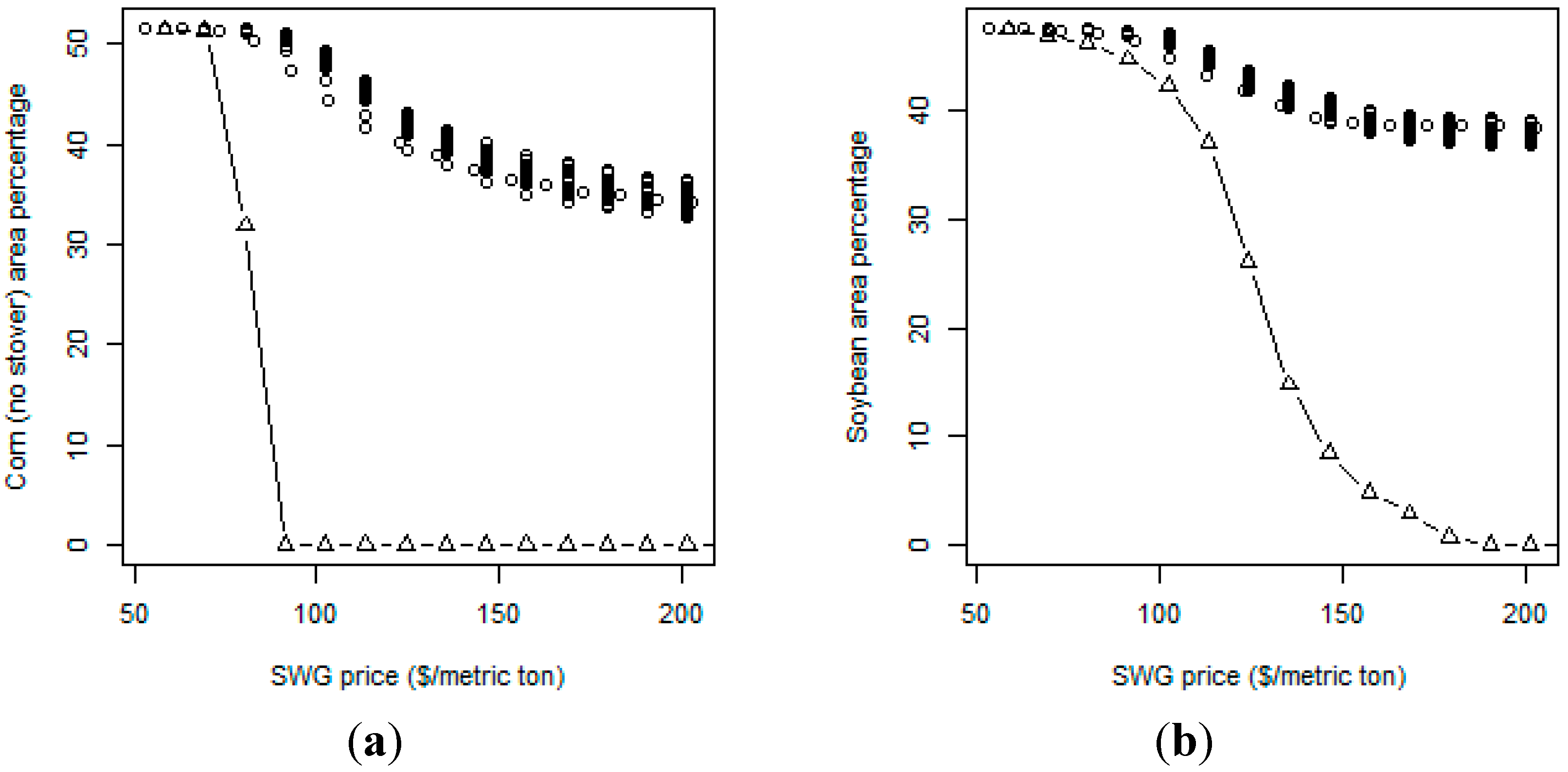
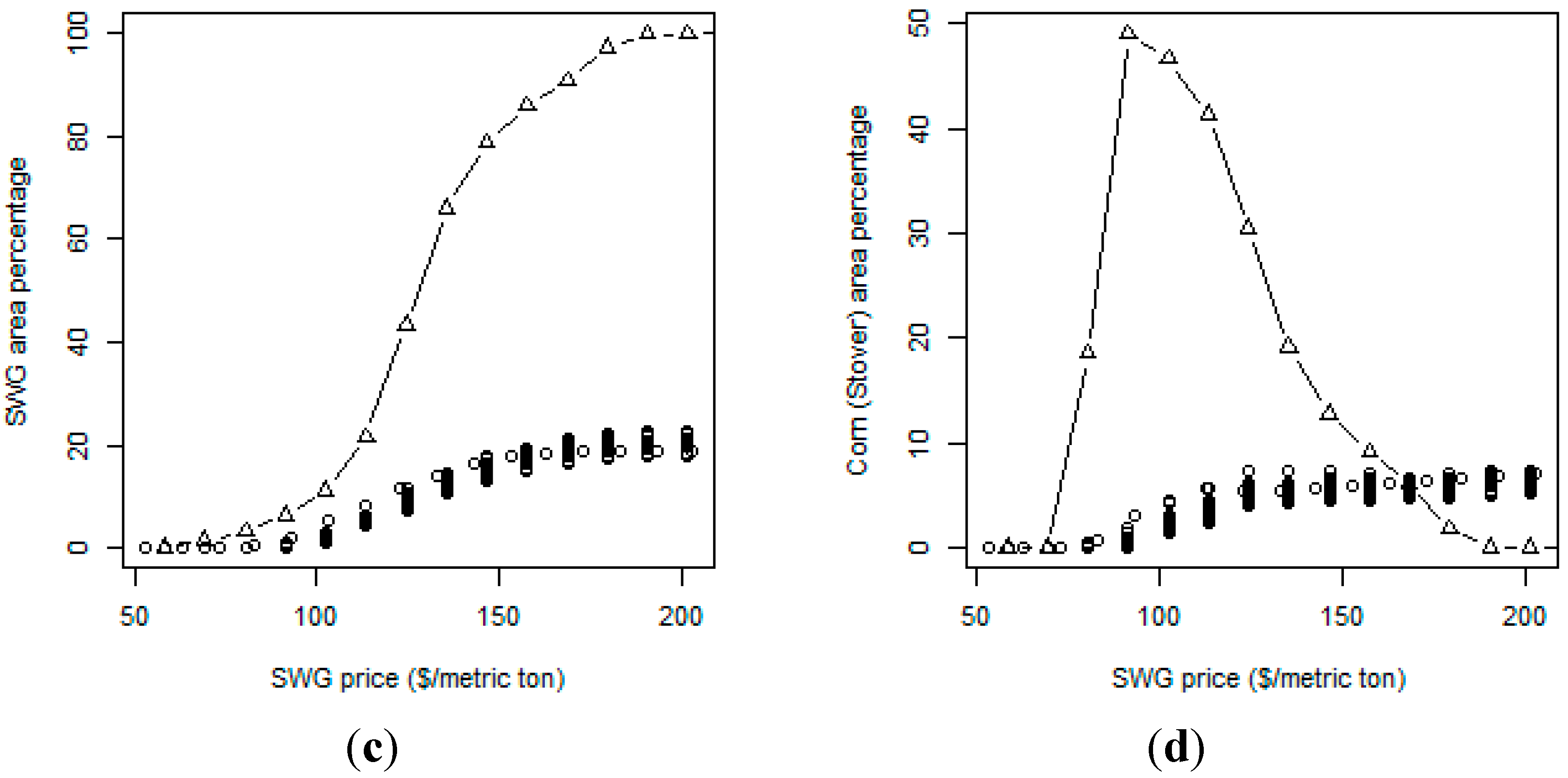

6.2.2. Impacts of Corn Stover and Switchgrass Price (Simulation Set IV)
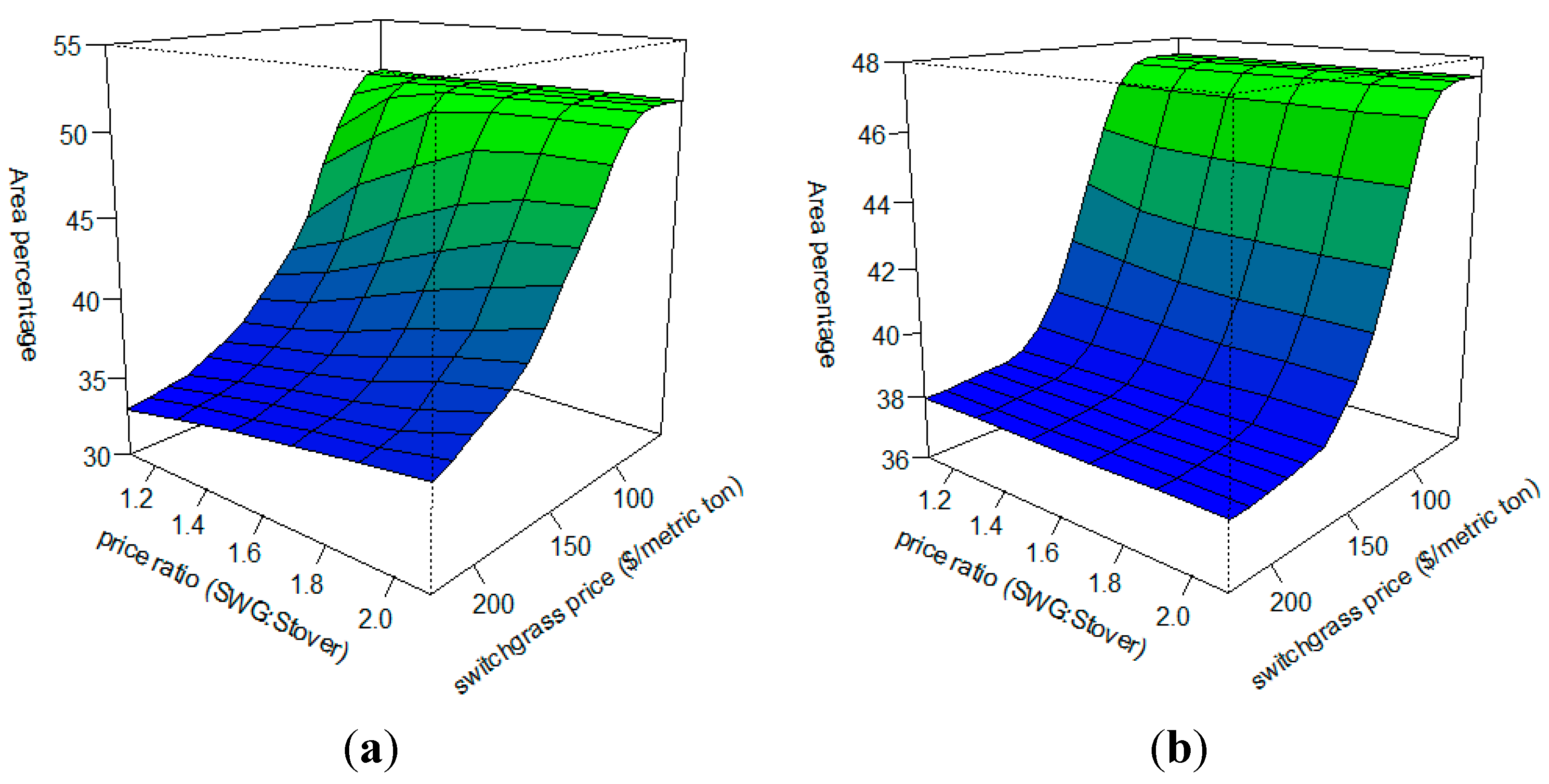

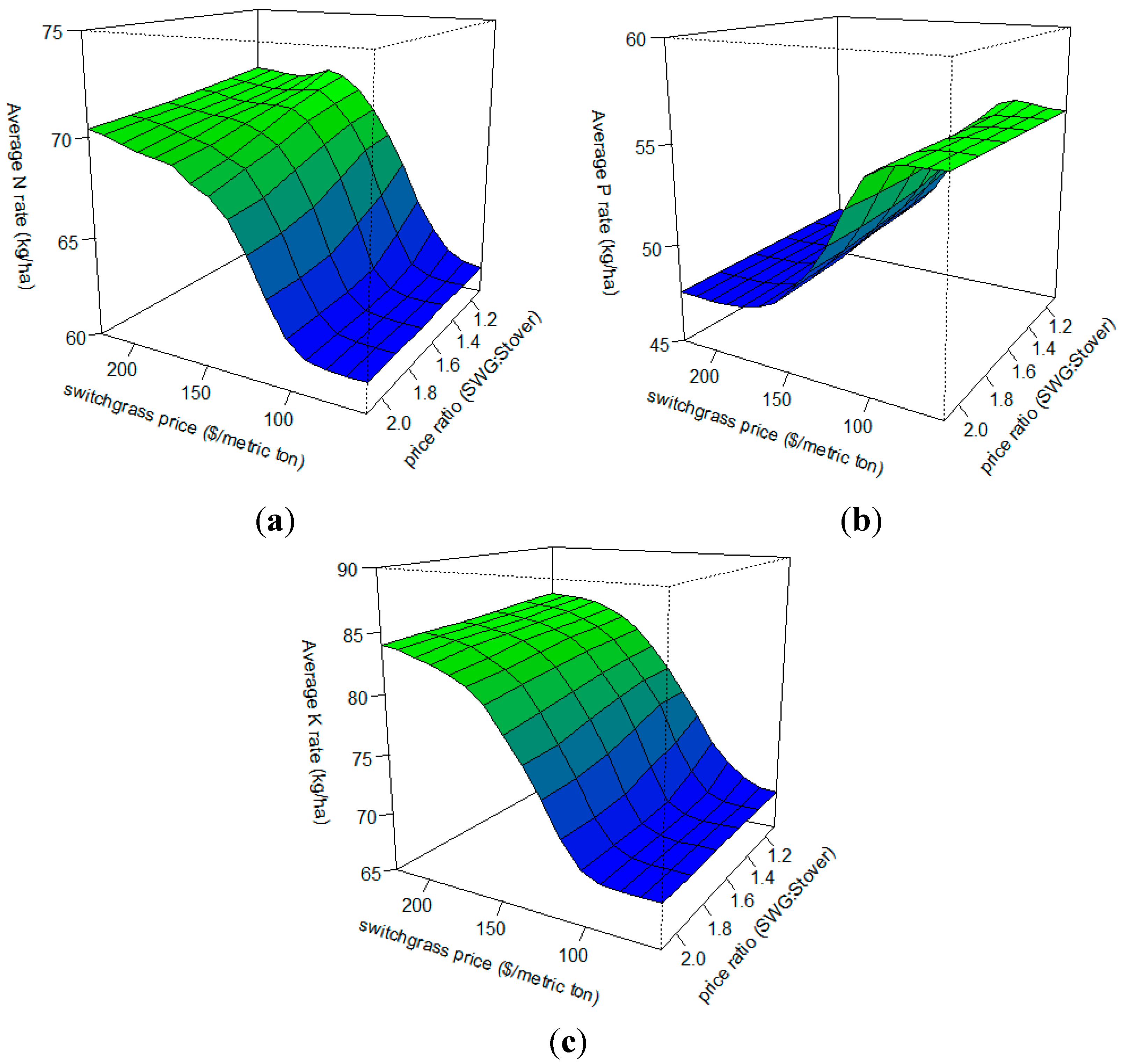
7. Conclusions
Acknowledgments
Author Contributions
Conflicts of Interest
Appendix
A. Crop Yield Drag Coefficients and Fertilizer Rates

B. Empirical Parameters and Parameterization
| Question # | Question |
|---|---|
| 3 | Do you consider yourself a farmer? |
| 18c | Number of acres you own that you farmed in 2009 |
| 18d | Number of acres you leased or rented to other people to farm in 2009 |
| 18e | Number of acres you rented from others to farm in 2009 |
| 18f | Number of acres in the Conservation Reserve Program (CRP) in 2009 |
| 48 | What is the minimum net profit per acre you would need to get in order to consider marketing corn stover? |
| 49 | If you could get that profit per acre, how many acres of corn stover would you consider harvesting? |
| 50 | If you supplied corn stover to a bio-refinery, would you prefer to harvest 30%, 50%, or 70% of the corn stover in your fields? |
| 51 | If you could get a net profit 50% higher than what you indicated in question 48, how many acres of corn stover in total would you consider harvesting? |
| 56 | What is the minimum net profit per acre you would need to get in order to consider growing switchgrass? |
| 57 | If you could get that profit per acre, how many acres of switchgrass you consider planting? |
| 58 | If you could get a net profit 50% higher than what you indicated in question 55, how many acres of switchgrass in total would you consider growing? |
| Type | Profit SWG | Percent1 SWG | Percent2 SWG | Profit Stvr | Percent1 Stvr | Percent2 Stvr | Portion Stvr | |
|---|---|---|---|---|---|---|---|---|
| Profit SWG | 1 or 2 | 1 | 0.4145 (0.1407) | na * | na | na | na | na |
| 3 | 1 | −0.2488 (0.1560) | na | 0.8471 (2.03 × 10−11) | na | na | na | |
| Percent1 SWG | 1 or 2 | 1 | 0.9687 (4.18 × 10−11) | na | na | na | na | |
| 3 | 1 | 0.8885 (1.06 × 10−12) | na | 0.6822 (3.31×10−6) | na | na | ||
| Percent2 SWG | 1 or 2 | 1 | na | na | na | na | ||
| 3 | 1 | na | na | na | na | |||
| Profit Stvr | 1 or 2 | 1 | 0.1918 (0.4768) | na | −0.0525 (0.8526) | |||
| 3 | 1 | −0.1714 (0.3248) | na | −0.0648 (0.7033) | ||||
| Percent1 Stvr | 1 or 2 | 1 | 0.8897 (9.01 × 10−6) | na | ||||
| 3 | 1 | 0.8952 (1.76 × 10−13) | na | |||||
| Percent2 Stvr | 1 or 2 | 1 | na | |||||
| 3 | 1 | na | ||||||
| Portion Stvr | 1 or 2 | 1 | ||||||
| 3 | 1 |
References
- O’Neal, M.R.; Nearing, M.A.; Vining, R.C.; Southworth, J.; Pfeifer, R.A. Climate change impacts on soil erosion in Midwest United States with changes in crop management. Catena 2005, 61, 165–184. [Google Scholar] [CrossRef]
- Lettenmaier, D.P.; Hooper, E.R.; Wagoner, C.; Faris, K.B. Trends in stream quality in the continental United States, 1978–1987. Water Resour. Res. 1991, 27, 327–339. [Google Scholar] [CrossRef]
- Yadav, V.; Malanson, G.P.; Bekele, E.; Lant, C. Modeling watershed-scale sequestration of soil organic carbon for carbon credit programs. Appl. Geogr. 2009, 29, 488–500. [Google Scholar] [CrossRef]
- Bekele, E.G.; Lant, C.L.; Soman, S.; Misgna, G. The evolution and empirical estimation of ecological-economic production possibilities frontiers. Ecol. Econ. 2013, 90, 1–9. [Google Scholar] [CrossRef]
- Secchi, S.; Gassman, P.W.; Jha, M.; Kurkalova, L.; Kling, C.L. Potential water quality changes due to corn expansion in the Upper Mississippi River Basin. Ecol. Appl. 2011, 21, 1068–1084. [Google Scholar] [CrossRef] [PubMed]
- Secchi, S.; Kurkalova, L.; Gassman, P.W.; Hart, C. Land use change in a biofuels hotspot: The case of Iowa, USA. Biomass Bioenergy 2011, 35, 2391–2400. [Google Scholar] [CrossRef]
- Kurkalova, L.A.; Secchi, S.; Gassman, P.W. Corn stover harvesting: Potential supply and water quality implications. In Handbook of Bioenergy Economics and Policy; Khanna, M., Scheffran, J., Zilberman, D., Eds.; Springer-Verlag: New York, NY, USA, 2010; pp. 307–323. [Google Scholar]
- Lee, K.H.; Isenhart, T.M.; Schultz, R.C.; Mickelson, S.K. Nutrient and sediment removal by switchgrass and cool-season grass filter strips in central Iowa, USA. Agrofor. Syst. 1998, 44, 121–132. [Google Scholar] [CrossRef]
- Sarkar, S.; Miller, S.A.; Frederick, J.R.; Chamberlain, J.F. Modeling nitrogen loss from switchgrass agricultural systems. Biomass Bioenergy 2011, 35, 4381–4389. [Google Scholar] [CrossRef]
- Parker, D.C.; Manson, S.M.; Janssen, M.A.; Hoffmann, M.J.; Deadman, P. Multi-agent systems for the simulation of land-use and land-cover change: A review. Ann. Assoc. Am. Geogr. 2003, 93, 314–337. [Google Scholar] [CrossRef]
- Bennett, D.A.; Tang, W.; Wang, S. Toward an understanding of provenance in complex land use dynamics. J. Land Use Sci. 2011, 6, 211–230. [Google Scholar] [CrossRef]
- Matthews, R.; Gilbert, N.G.; Roach, A.; Polhill, J.; Gotts, N.M. Agent-based land-use models: A review of applications. Landsc. Ecol. 2007, 22, 1447–1459. [Google Scholar] [CrossRef] [Green Version]
- Robinson, D.T.; Brown, D.G.; Parker, D.C.; Schreinemachers, P.; Janssen, M.A.; Huigen, M.G.A.; Wittmer, H.; Gotts, N.M.; Promburom, P.; Irwin, E.G.; et al. Comparison of empirical methods for building agent-based models in land use science. J. Land Use Sci. 2007, 2, 31–55. [Google Scholar] [CrossRef]
- Smajgl, A.; Brown, D.G.; Valbuena, D.; Huigen, M.G.A. Empirical characterisation of agent behaviours in socio-ecological systems. Environ. Model. Softw. 2011, 26, 837–844. [Google Scholar] [CrossRef]
- Manson, S.M. Challenges in evaluating models of geographic complexity. Environ. Plan. B Plan. Design 2007, 34, 245–260. [Google Scholar] [CrossRef]
- Matthews, R. The people and landscape model (palm): Towards full integration of human decision-making and biophysical simulation models. Ecol. Model. 2006, 194, 329–343. [Google Scholar] [CrossRef]
- Matthews, R.; Selman, P. Landscape as a focus for integrating human and environmental processes. J. Agric. Econ. 2006, 57, 199–212. [Google Scholar] [CrossRef]
- Epstein, J.M. Generative Social Science: Studies in Agent-Based Computational Modeling; Princeton University Press: Princeton, NJ, USA, 2006. [Google Scholar]
- Lansing, J.S.; Kremer, J.N. Emergent properties of Balinese water temple networks: Coadaptation on a rugged fitness landscape. Am. Anthropol. 1993, 95, 97–114. [Google Scholar] [CrossRef]
- Le, Q.B.; Park, S.J.; Vlek, P.L.G. Land Use Dynamic Simulator (LUDAS): A multi-agent system model for simulating spatio-temporal dynamics of coupled human-landscape system 2. Scenario-based application for impact assessment of land-use policies. Ecol. Inform. 2010, 5, 203–221. [Google Scholar] [CrossRef]
- Le, Q.B.; Park, S.J.; Vlek, P.L.G.; Cremers, A.B. Land-Use Dynamic Simulator (LUDAS): A multi-agent system model for simulating spatio-temporal dynamics of coupled human-landscape system. I. Structure and theoretical specification. Ecol. Inform. 2008, 3, 135–153. [Google Scholar] [CrossRef]
- Bousquet, F.; Le Page, C. Multi-agent simulations and ecosystem management: A review. Ecol. Model. 2004, 176, 313–332. [Google Scholar] [CrossRef]
- Sengupta, R.; Lant, C.; Kraft, S.; Beaulieu, J.; Peterson, W.; Loftus, T. Modeling enrollment in the Conservation Reserve Program by using agents within spatial decision support systems: An example from southern Illinois. Environ. Plan. B Plan. Des. 2005, 32, 821–834. [Google Scholar] [CrossRef]
- Scheffran, J.; BenDor, T. Bioenergy and land use: A spatial-agent dynamic model of energy crop production in Illinois. Int. J. Environ. Pollut. 2009, 39, 4–27. [Google Scholar] [CrossRef]
- Ng, T. Response of Farmers’ Decisions and Stream Water Quality to Price Incentives for Nitrogen Reduction, Carbon Abatement, and Miscanthus Cultivation: Preditions Based on Agent-Based Modeling Coupled with Water Quality Modeling. Ph.D. Dissertation, University of Illinois at Urbana-Champaign, Urbana-Champaign, IL, USA, 2010. [Google Scholar]
- Ng, T.; Eheart, J.W.; Cai, X.M.; Braden, J.B. An agent-based model of farmer decision-making and water quality impacts at the watershed scale under markets for carbon allowances and a second-generation biofuel crop. Water Resour. Res. 2011, 47. [Google Scholar] [CrossRef]
- Schreinemachers, P.; Berger, T. Land use decisions in developing countries and their representation in multi-agent systems. J. Land Use Sci. 2006, 1, 29–44. [Google Scholar] [CrossRef]
- Berger, T.; Schreinemachers, P. Creating agents and landscapes for multiagent systems from random samples. Ecol. Soc. 2006, 11, 19. [Google Scholar]
- Castella, J.C.; Verburg, P.H. Combination of process-oriented and pattern-oriented models of land-use change in a mountain area of Vietnam. Ecol. Model. 2007, 202, 410–420. [Google Scholar] [CrossRef]
- Torii, D.; Bousquet, F.; Ishida, T.; Trébuil, G.; Vejpas, C. Using Classification Learning in Companion Modeling Multi-Agent Systems for Society; Lukose, D., Shi, Z., Eds.; Springer: Berlin/Heidelberg, Germany, 2009; Volume 4078, pp. 255–269. [Google Scholar]
- Brown, D.G.; Robinson, D.T. Effects of heterogeneity in residential preferences on an agent-based model of urban sprawl. Ecol. Soc. 2006, 11, 46. [Google Scholar]
- Huigen, M.G.A. First principles of the mameluke multi-actor modelling framework for land use change, illustrated with a Philippine case study. J. Environ. Manag. 2004, 72, 5–21. [Google Scholar] [CrossRef] [PubMed]
- Castillo, D.; Saysel, A.K. Simulation of common pool resource field experiments: A behavioral model of collective action. Ecol. Econ. 2005, 55, 420–436. [Google Scholar] [CrossRef]
- Irwin, E.G.; Bockstael, N.E. Interacting agents, spatial externalities and the evolution of residential land use patterns. J. Econ. Geogr. 2002, 2, 31–54. [Google Scholar] [CrossRef]
- Brown, D.G.; Robinson, D.T.; An, L.; Nassauer, J.I.; Zellner, M.; Rand, W.; Riolo, R.; Page, S.E.; Low, B.; Wang, Z.F. Exurbia from the bottom-up: Confronting empirical challenges to characterizing a complex system. Geoforum 2008, 39, 805–818. [Google Scholar] [CrossRef]
- Druschke, C.G.; Secchi, S. The impact of gender on agricultural conservation knowledge and attitudes in an Iowa watershed. J. Soil Water Conserv. 2014, 69, 12. [Google Scholar] [CrossRef]
- Varble, S.; Druschke, C.G.; Secchi, S. An examination of growing trends in land tenure and conservation practice adoption: Results from a farmer survey in Iowa. Environ. Manag. 2015. [Google Scholar] [CrossRef] [PubMed]
- Iowa State University Extension. Nitrogen Fertilizer Recommendations for Corn in Iowa; Leopold Center: Ames, IA, USA, 1997; Available online: http://www.iasoybeans.com/advancenewsletter/PDF/ADV15_0611_4_PM1714.pdf (accessed on 1 October 2015).
- Grimm, V.; Berger, U.; DeAngelis, D.L.; Polhill, J.G.; Giske, J.; Railsback, S.F. The ODD protocol: A review and first update. Ecol. Model. 2010, 221, 2760–2768. [Google Scholar] [CrossRef]
- Duffy, M. Estimated Costs for Production, Storage and Transportation of Switchgrass; Iowa State University Extension: Ames, IA, USA, 2008; Available online: https://www.extension.iastate.edu/agdm/crops/pdf/a1-22.pdf (accessed on 1 October 2015).
- Edwards, W. Estimating a Value for Corn Stover; Iowa State University Extension: Ames, IA, USA, 2014; Available online: https://www.extension.iastate.edu/agdm/crops/pdf/a1-70.pdf (accessed on 1 October 2015).
- Johanns, A.M. Iowa Cash Corn and Soybean Prices; Iowa State University Extension and Outreach: Ames, IA, USA, 2015; Available online: http://www.extension.iastate.edu/agdm/crops/pdf/a2-11.pdf (accessed on 1 October 2015).
- Food and Agricultural Policy Research Institute. U.S. Baseline Briefing Book: Projections for Agricultural and Biofuel Markets; University of Missouri: Columbia, MO, USA, 2015; Available online: http://www.fapri.missouri.edu/wp-content/uploads/2015/03/FAPRI-MU-Report-01-15.pdf (accessed on 1 October 2015).
- Food and Agricultural Policy Research Institute. Competition for Biomass among Renewable Energy Policies: Liquid Fuels Mandate versus Renewable Electricity Mandate; University of Missouri: Columbia, MO, USA, 2011; Available online: http://www.fapri.missouri.edu/wp-content/uploads/2015/02/FAPRI-MU-Report-11-11.pdf (accessed on 1 October 2015).
- Davidson, D. Corn on Corn: How Much Yield is Enough; Progressive Farmer: Birmingham, AL, USA, 2007. [Google Scholar]
- Smith, P. The Pros and Cons of Going corn-on-Corn; Fields of Facts: Brandon, MS, USA, 2013; Available online: http://agfax.com/2013/09/23/the-pros-and-cons-of-going-corn-on-corn/ (accessed on 1 October 2015).
- Edwards, W.; Johanns, A.M. Cash Rental Rates for Iowa 2012 Survey; Iowa State University Extension and Outreach: Ames, IA, USA, 2013; Available online: https://www.extension.iastate.edu/agdm/wholefarm/pdf/c2–10_2012.pdf (accessed on 1 October 2015).
- McLaughlin, S.B.; Walsh, M.E. Evaluating environmental consequences of producing herbaceous crops for bioenergy. Biomass Bioenergy 1998, 14, 317–324. [Google Scholar] [CrossRef]
- Lee, K.H.; Isenhart, T.M.; Schultz, R.C. Sediment and nutrient removal in an established multi-species riparian buffer. J. Soil Water Conserv. 2003, 58, 1–8. [Google Scholar]
- Mann, L.; Tolbert, V.; Cushman, J. Potential environmental effects of corn (Zea mays L.) stover removal with emphasis on soil organic matter and erosion. Agric. Ecosyst. Environ. 2002, 89, 149–166. [Google Scholar] [CrossRef]
- Iowa State University Extension. A General Guide for Crop Nutrient and Limestone Recommendations in Iowa; Iowa State University Extension and Outreach: Ames, IA, USA, 2013; Available online: http://store.extension.iastate.edu/Product/A-General-Guide-for-Crop-Nutrient-and-Limestone-Recommendations-in-Iowa-PDF (accessed on 1 October 2015).
© 2015 by the authors; licensee MDPI, Basel, Switzerland. This article is an open access article distributed under the terms and conditions of the Creative Commons Attribution license (http://creativecommons.org/licenses/by/4.0/).
Share and Cite
Ding, D.; Bennett, D.; Secchi, S. Investigating Impacts of Alternative Crop Market Scenarios on Land Use Change with an Agent-Based Model. Land 2015, 4, 1110-1137. https://doi.org/10.3390/land4041110
Ding D, Bennett D, Secchi S. Investigating Impacts of Alternative Crop Market Scenarios on Land Use Change with an Agent-Based Model. Land. 2015; 4(4):1110-1137. https://doi.org/10.3390/land4041110
Chicago/Turabian StyleDing, Deng, David Bennett, and Silvia Secchi. 2015. "Investigating Impacts of Alternative Crop Market Scenarios on Land Use Change with an Agent-Based Model" Land 4, no. 4: 1110-1137. https://doi.org/10.3390/land4041110





